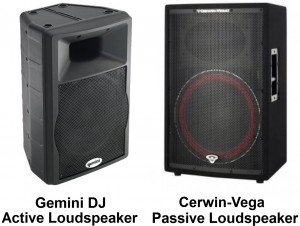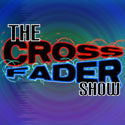by Ben Stowe, CTS - “Sound & Lighting Guru”
There are so many choices we have to make. Paper or Plastic? Mac or PC? Star Wars or Star Trek?…just to name a few.
The one choice that perplexes DJs to the point where many just go along with what’s popular with their peers is “Active” versus “Passive.” I’m not talking about MCing style here, I’m talking about loudspeakers.

Fundamentally the question really is, where do you want your amp? A passive loudspeaker must be connected to an amplifier, whereas an active loudspeaker has an amplifier built into the enclosure of the speaker.
The Common Thought Process
Every time someone tells me they want to buy an active speaker because they don’t want to carry an amplifier, I feel compelled to remind them that not only do they STILL have to carry an amplifier (it’s just that now it’s inside the speaker), they also likely have to lift it onto a speaker stand.
The other ironic statement I hear is that people say they don’t want to have to run speaker cords. The hang-up with this is that in order to use an active speaker you need to run TWO cords to it. One for audio signal, and another for AC power.
There are some exceptions here, such as a battery-powered speaker with a wireless signal, but that’s not really apples to apples for most applications.
The Pros and Cons of Each Choice
Now that we’ve cleared the air, which is better? Well, the convenience of having an amplifier built into the loudspeaker can be really nice. It allows each loudspeaker to be used and placed independently, whereas most power amplifiers used by DJs have 2 channels in them, so splitting up a pair of passive loudspeakers might be more difficult.
Plus, if you’re using table-top racks and coffins you may not have vertical rack space available for the amp, and why carry another rack when you can just carry the amp conveniently inside your loudspeakers?
Also, active loudspeakers often have some form of signal processing built into them, and this simplifies the connection of the signal when multiple enclosures are in use. A full range signal can be run out of the mixer and into a subwoofer and then on to a full range box, for example.
Many times the full range boxes will have a switch that indicates if it is being used with a subwoofer or not, and when activated automatically sets the crossover point appropriately.
If you’re a geek like me though, you’ll enjoy getting your hands dirty setting roll-offs and arguing the merits between a Butterworth crossover and a Linkwitz-Riley crossover.
The Ancient Struggle Between
Engineering and Marketing
It stands to reason that manufacturers would perfectly match the amplifier to the loudspeaker and save you all the trouble of that pesky math, right?
Well, in a perfect world that would be the case, and by and large they do a pretty good job. However, there is an unseen battle going on everywhere product development occurs. It’s an ancient struggle between engineering and marketing.
Left unchecked, engineers would overbuild everything and include not one, but two flux capacitors (as if they were building a DeLorean Time Machine) with every powered speaker.
On the other side of the equation, marketing would like to pretend most of physics doesn’t exist, and the product could be made for as close to free as possible to ensure a very competitive position in the marketplace.
This battle means that a balance must be sought with regard to weight, performance and cost.
A Quick Comparison
Here are a top-tier pro-audio manufacturer’s loudspeaker offerings. They are identical except that the left side are passive loudspeakers and the right side are active loudspeakers.
| 12” 2-way Passive = 35 lbs. | 12” 2- way Active = 37 lbs. |
| 15” 2-way Passive = 48 lbs. | 15” 2- way Active = 50 lbs. |
| 18” Subwoofer Passive = 67 lbs. | 18” Subwoofer Active = 69 lbs. |
You can see how effectively engineers have reduced the weight of the active amplifiers for the enclosure. However, in order to put a lightweight, inexpensive amplifier in the box, some performance must be sacrificed. These amplifiers are trimmed down versions of their more robust rack-mounted cousins.
My Preference
It is my belief that a properly configured and adequately powered passive system is preferential with regards to overall performance. However, ultimately it is up to you to decide what balance of features is best for your application.
Oh, and by the way, regarding the first choices I mentioned in this article…I prefer Plastic, Mac, and Star Wars.
Which type of speaker do you prefer, and why?








